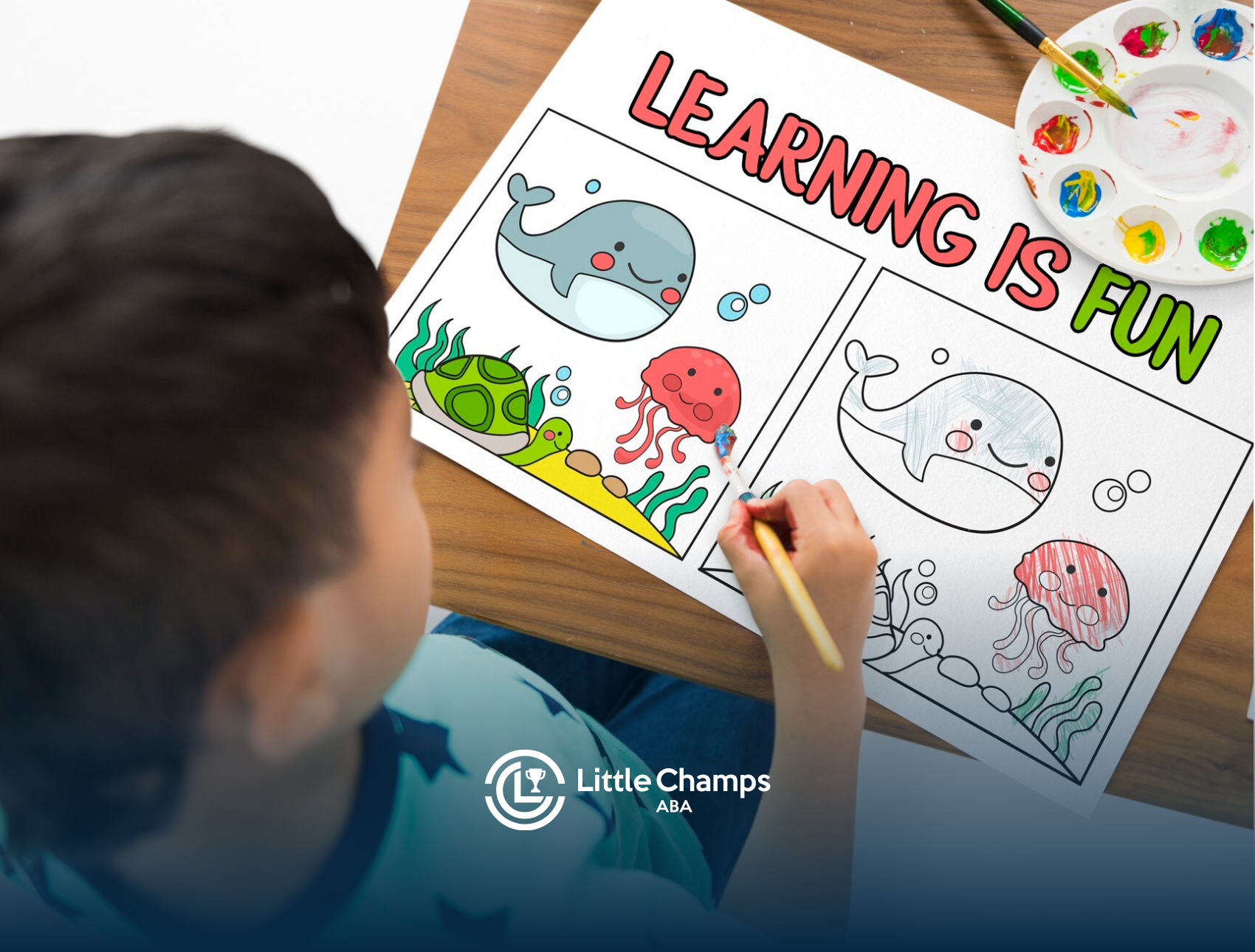
Visual Learning Strategies
Visual learning strategies play a crucial role in autism education. This section explores the benefits of visual schedules and how they support language development in autistic learners.
Benefits of Visual Schedules
Visual schedules can significantly enhance the learning experience of autistic individuals by providing structure and predictability. They can improve a child’s behavior by providing a sense of calmness and reducing anxiety associated with an unknown or changing daily schedule.
Key Benefits of Visual Schedules:
- Improved Behavior: The predictability of visual schedules helps to reduce anxiety and provides a sense of security.
- Enhanced Focus: By offering a visual representation of the day’s activities, children can better focus on specific tasks.
- Customization: Visual schedules can be personalized with motivating pictures or photographs, which makes them more engaging.
| Benefit | Description |
|---|---|
| Improved Behavior | Reduces anxiety and provides a sense of security. |
| Enhanced Focus | Visual representation improves attention and task engagement. |
| Customization | Personalized with motivating images to enhance engagement. |
For more strategies on managing autism learning styles, refer to our section on autism learning styles.
Supporting Language Development
Visual tools are integral in supporting the language development of autistic individuals. Visual schedules allow children to look at a visual representation while instructions and concepts are being spoken, which can support a child’s language development.
Pairing key vocabulary with visual support during reading sessions can be particularly beneficial. This method helps individuals identify crucial elements of the text and improve comprehension. By incorporating symbols or pictures alongside key vocabulary, autistic learners can better grasp social narratives and improve their interactions with peers and adults. For additional methods, explore our section on technology-assisted learning for autism.
| Strategy | Benefit |
|---|---|
| Visual Schedules | Helps with comprehension and following instructions. |
| Key Vocabulary Pairing | Enhances understanding of social narratives. |
Understanding the communication differences in autism is essential for implementing these strategies effectively. For auditory learning techniques, visit our detailed guide on auditory learning techniques for autism.
Visual Tools for Autistic Learners
Understanding the unique learning styles of autistic individuals is crucial for providing effective educational support. Many autistic children are highly visual learners and rely on seeing new information to best retain it.
Tools for Visual Learners
Visual learners greatly benefit from a range of tools and techniques designed specifically to cater to their learning style. According to Forbrain, some of the most effective tools include:
- Video Modeling: Demonstrates desired behaviors or skills through videos, allowing learners to see examples and imitate them.
- Graphic Organizers: Visual representations of concepts and relationships between ideas, helping in organizing and understanding information.
- Picture Schedules: A series of images depicting the sequence of activities, aiding in routine management and transition between tasks.
- Diagrams and Visual Aids: Simplify complex information into visual formats like charts and graphs for easier comprehension.
- Written Instructions: Provide clear, step-by-step directions in written form to reinforce understanding.
By incorporating these tools into daily learning, autistic children can access information more effectively and succeed in academic environments. Visual strategies are an integral part of visual learning strategies for autism and support various aspects of learning and development.
Strategies for Auditory Learners
While visual strategies are vital, it’s also important to address the needs of auditory learners. Auditory learners absorb information best through listening and verbal instructions. To support these learners, consider implementing:
- Auditory Instructions: Verbal directions and explanations help auditory learners grasp concepts better.
- Audio Books and Recordings: Listening to information instead of reading can improve understanding and retention.
- Interactive Discussions: Engaging in conversations and verbal exchanges facilitates learning through hearing and speaking.
Techniques for Kinesthetic Learners
Kinesthetic learners learn best through hands-on experiences and physical activities. To support these learners, consider using:
- Hands-on Activities: Engage learners in activities that involve manipulating objects or participating in experiments.
- Movement-based Learning: Incorporate physical movement into lessons, such as role-playing or interactive games.
- Sensory Activities: Utilize sensory tools like tactile materials or fidget toys to enhance learning through touch and movement.
By adopting the right techniques, kinesthetic learners can thrive in their educational environment. Combining these methods with visual supports can further enhance their overall learning experience.
Personalized Learning Approaches
Personalized learning is essential for supporting autistic individuals in their educational journey. Tailoring strategies to fit unique learning styles can significantly enhance their academic and social development.
Read/Write Learner Strategies
Read/write learners with autism benefit from methods that utilize written text to convey information and allow self-expression. Strategies for read/write learners include:
- Encouraging note-taking during lessons.
- Providing written materials and handouts.
- Facilitating participation in discussion boards.
- Engaging them in written projects or essays.
- Offering ample opportunities for reading and writing exercises.
These strategies help read/write learners process and retain information effectively, fostering academic success.
Social Skills Development
Developing social skills can be challenging for individuals with autism. Personalized teaching stories are a powerful tool for honing these skills. These stories:
- Provide a visual framework outlining expected behaviors.
- Foster understanding of social situations.
- Reduce anxiety in unfamiliar settings.
Incorporating visuals, such as symbols or pictures, alongside key vocabulary, helps individuals grasp social narratives, improving interactions with peers and adults.
Understanding Social Cues
Understanding and interpreting social cues is another area where autistic individuals may face challenges. Visual modeling plays a crucial role by providing clear visual support. Visual supports can:
- Help autistic individuals learn and understand social cues.
- Improve their ability to interpret and respond appropriately in social situations.
Utilizing tools like video modeling, graphic organizers, and picture schedules can enhance their ability to navigate social environments. For more resources and strategies, check out our articles on autism learning styles and technology-assisted learning for autism.
By implementing these personalized approaches, educators and caregivers can create a supportive learning environment that empowers autistic individuals to achieve their full potential.
Importance of Visual Supports
For individuals with autism, visual supports play a critical role in facilitating learning and communication. These tools offer a tangible and often easier-to-understand representation of concepts, aiding in the comprehension and retention of information.
Customization and Accessibility
Customization and accessibility of visual supports are paramount for effective learning. Customization allows visuals to be tailored specifically to the individual’s needs, ensuring that they are relevant and engaging. For example, personalized teaching stories provide a visual framework that outlines expected behaviors, fostering understanding and reducing anxiety in unfamiliar settings.
These supports are accessible to various learning styles, making them versatile tools for individuals with different needs. Visual schedules, for instance, can enhance communication by allowing children to look at a visual representation while instructions and concepts are being spoken. This dual input supports language development and aids in comprehension.
| Visual Tool | Customization Options | Accessibility Features |
|---|---|---|
| Visual Schedules | Tailored activities, personalized icons | Easy to update, interactive |
| Social Stories | Custom scenarios, name-specific | Context-specific, flexible |
| Visual Timers | Adjustable durations, color options | Clear time indication, auditory alerts |
Enhancing Communication Skills
Visual supports significantly aid in enhancing communication skills among autistic individuals. Effective use of these tools can promote independence, reduce frustration, and minimize anxiety. Autistic communication differences are a core characteristic of autism, encompassing social communication and interaction disparities compared to non-autistic individuals.
Visual supports, such as visual schedules and customized storyboards, help bridge the communication gap by providing clear and consistent cues. These supports can assist students with ASD in understanding and adapting to changes in routines, helping them tolerate change and increase flexibility in participating in new activities.
By leveraging visual supports, educators and families can create a more inclusive and effective learning environment for autistic individuals. Visual aids not only facilitate better understanding but also empower the learner by providing them with tools to navigate their daily lives more confidently.
Challenges in Communication
Effective communication can be a significant challenge for autistic individuals. Understanding the inherent differences and how to bridge the gap is crucial for fostering a supportive learning environment.
Communication Differences in Autism
Social communication and interaction differences are core characteristics of autism. These disparities must be present for an autism diagnosis, but they can vary widely among autistic people. Traditionally, research into autistic communication has focused on perceived deficits compared to non-autistic individuals. However, advances in understanding autism suggest that autistic individuals might have different communication skills or preferences rather than lacking them.
Evidence indicates that autistic individuals may have more effective information-sharing and greater rapport, flow, and empathy with other autistic people than with non-autistic individuals. These differences highlight the importance of recognizing and accommodating diverse communication styles in educational and social settings.
Overcoming Communication Barriers
Traditional support strategies and therapies often focus on training autistic individuals to mimic non-autistic communication styles, leading to “masking” of autistic characteristics. This masking can be exhausting, causing stress and anxiety that may result in mental health issues. Instead of forcing autistic individuals to conform, it is more beneficial to develop mutual understanding and accommodations.
The “double empathy problem” theory, proposed by autism researcher Dr. Damian Milton, suggests that both autistic and non-autistic people may face difficulties understanding each other’s communication styles. Effort is required from both sides to bridge this communication gap effectively.
Key Strategies for Overcoming Barriers
- Visual Supports: Use visual schedules and other visual learning strategies for autism to enhance understanding and structure.
- Technological Assistance: Integrate technology-assisted learning tools such as tablets or software that cater to visual learning.
- Customized Approaches: Develop personalized autism learning styles and tailor communication methods to individual preferences.
- Social Skills Training: Engage in social skills training for autism to improve interaction skills in a supportive setting.
- Focus on Mutual Understanding: Implement practices that foster empathy and understanding between autistic and non-autistic individuals.
Encouraging the use of visual supports and recognizing the unique communication styles of autistic individuals are essential steps towards fostering effective communication and creating an inclusive learning environment.
Structured Learning Environment
A structured learning environment is essential for supporting autistic students in achieving their full potential. This section explores key strategies for creating such an environment, focusing on transition support, priming strategies, and the use of social stories and video priming.
Transition Support for Autistic Students
Supporting transitions is crucial for students on the autism spectrum. Changes in daily activities and routines can be particularly challenging. Providing a predictable environment and routine helps prevent rigidity or inflexible behavior, making the learning experience smoother.
Visual supports, such as visual schedules, are invaluable in preparing students for changes. These tools outline the sequence of activities, helping students understand what to expect throughout their day. For personalized methods to improve social interactions, read more about social skills training for autism.
Priming Strategies
Priming involves previewing information or activities that a student may find challenging before they encounter the situation. This strategy has proven effective in helping autistic students adapt to new settings, activities, and routines. Priming can include a variety of methods, two of which are social stories and video priming.
Social Stories and Video Priming
Social Stories
Social stories explain social concepts and scenarios using visual supports. These stories prepare students with ASD for new routines and events, leading to increased participation and decreased challenging behaviors. Staff can quickly create modified social stories to help students cope with unforeseen changes.
| Benefits of Social Stories | Description |
|---|---|
| Increased Participation | Prepares students for new routines and events |
| Decreased Challenging Behaviors | Helps students cope with changes |
Video Priming
Video priming prepares students for upcoming events by walking them through the steps of an activity using a video recording. This method leverages the preferred activity of video viewing, reducing anxiety and disruptive behavior by making routines predictable. Video priming is effective in familiarizing students with new settings and increasing predictability in activities.
| Benefits of Video Priming | Description |
|---|---|
| Reduced Anxiety | Makes routines more predictable |
| Increased Familiarity | Helps students get used to new settings |
These structured learning strategies not only ease transitions but also enhance the overall learning experience for autistic students. By incorporating effective visual learning methods like these, educators can create a supportive and accommodating environment for all learners.
Conclusion
In conclusion, visual learning strategies provide a powerful foundation for supporting the educational and communication needs of autistic individuals. From visual schedules and storyboards to video modeling and graphic organizers, these tools foster structure, reduce anxiety, and promote independence. By tailoring approaches to each learner’s strengths, we can create more inclusive and effective environments where every child has the opportunity to thrive.
At Little Champs ABA, we specialize in using evidence-based strategies like these to support your child’s growth. Contact us today to learn how we can personalize a visual learning plan that fits your child’s unique needs!
Sources:
- https://www.forbrain.com/autism-learning/autism-learning-styles/
- https://www.autism.org.uk/advice-and-guidance/topics/communication/communication-tools/visual-supports
- https://www.autismparentingmagazine.com/autism-and-social-cues/
- https://www.autism.org.uk/advice-and-guidance/topics/behaviour/masking


